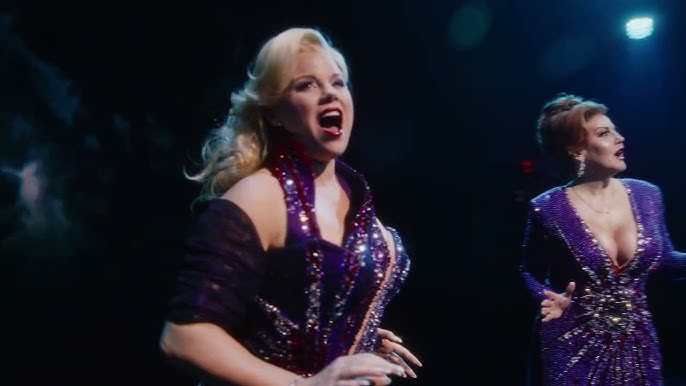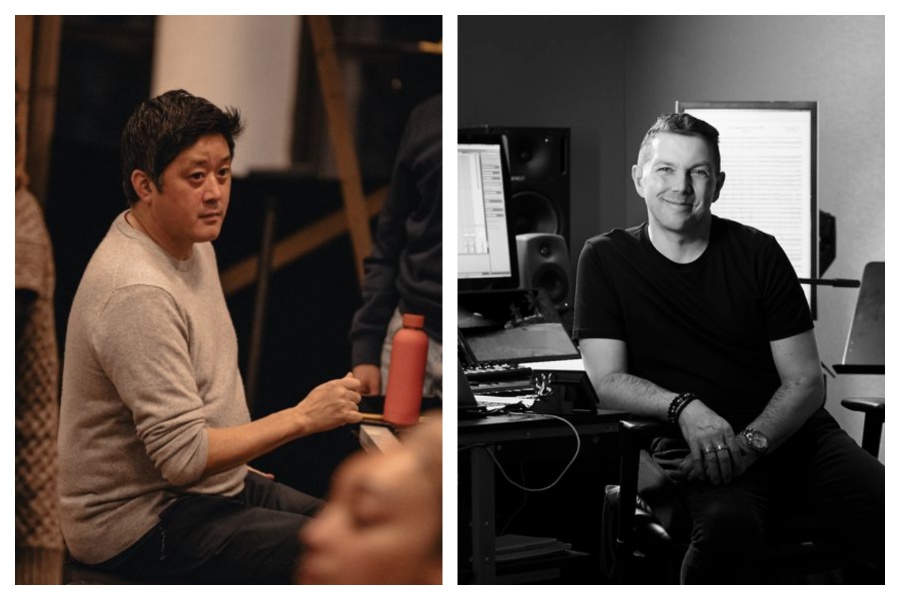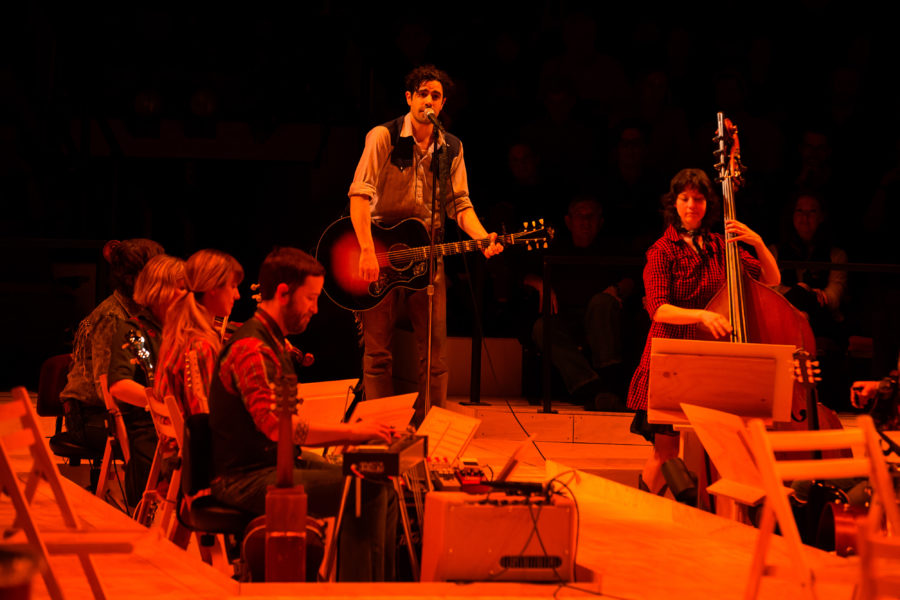In the singing land that is the musical theatre, orchestrators are too unsung. These showbiz pros do much to give a musical a distinctive sound and feel, and yet—the Tony Award for orchestrators notwithstanding—they often dwell in the shadow of composers, directors, and other creatives.
As the 2024-25 season draws to a close, American Theatre brought together two of these under-recognized artists with very different backgrounds and sounds. Both are currently represented on Broadway with hits.
For his part, the should-be-legendary Doug Besterman has not just one but three shows with his orchestrations on Broadway this season: Death Becomes Her, Boop!, and Smash. A three-time past Tony winner (for Fosse, The Producers, and Thoroughly Modern Millie), he has worked on more than 25 Broadway productions and has contributed to film (including to “Let It Go” from Frozen) and TV (Schmigadoon!).
Marco Paguia, who is onstage as music director of Buena Vista Social Club, inspired by the hit record of Cuban songs, has a résumé more geared toward band-leading, with previous credits like the Girl From the North Country, Gutenberg! The Musical!, and Berkeley Repertory Theatre’s Goddess (coming soon to the Public Theater, though with a different music director). Also the arranger of Buena Vista, he already won the 2024 Drama Desk and Outer Critics Circle awards for orchestrating that musical, based on its Off-Broadway run at the Atlantic Theater Company.
It seems a fair bet that he and Besterman are likely to be nominated for Tonys for their work this season. The two—who had not previously met—spoke over Zoom with Celia Wren. The conversation has been edited for length and clarity.
CELIA WREN: What should people know about orchestration that they probably don’t?
DOUG BESTERMAN: An orchestrator’s job is to take material that has been written, generally speaking, for piano, and has harmonic and melodic elements of the songs. We flesh it out for whatever the ensemble is for that project. I think of us as being the designer of the orchestra’s sound.
MARCO PAGUIA: The sitzprobe is probably the first time you get the other members of the creative team, like the director and choreographer, to hear what the orchestration sounds like. So maybe that’s the beginnings of some conversations about, “Oh, that’s different than what I was expecting.”
DOUG: You can’t start orchestrating much before the rehearsals begin, because things haven’t settled. Until you get into rehearsals, you may not know what key a number is in, or how much intro you need. So we have a lot of time pressure, put it that way.
Marco, how did you get into musical theatre?
MARCO: I’m a pianist first. I studied classical and jazz at Northwestern University, and also had done theatre. I had a friend who was in a Broadway show playing keyboard, and I was able to sub for him. Playing jazz, having a classical background, I felt strong in my ability to play different kinds of music. In the last 10 or 15 years, I was able to start music-directing more, and I’d always had an interest in arranging and orchestrating.
What’s kept me in musical theatre is the collaboration. I love being in a room with people who don’t do what I do: designers, directors, choreographers, and actors.
Doug, you realized what orchestration was early in your life, is that right?
DOUG: I grew up in the New York area, and my family were huge musical theatre fans. When I was a teenager, I became aware of the orchestrations. I remember specifically the cast album of A Chorus Line, listening and thinking: those trumpets!
I was a pianist first, and then a French horn player. I went to my piano teacher and said, “I want to learn how to orchestrate.” Around the same time, I asked my junior high school jazz band teacher if I could write something. I didn’t know that it was a hard thing to do. I found a program in college [at University of Rochester and its Eastman School of Music] that was essentially commercial arranging. I came to New York, and started to get assistant music director and music director jobs, but I would tell people, “I’m also an orchestrator.” Eventually, I was in the right place at the right time, and the phone rang, and I became an orchestrator in 1992.
It’s a business of relationships, of trust. There’s not a good way to present your work prior to just a few days before the audience is going to come in. So there’s a lot of pressure on us to get it right, but it is very collaborative.
We are in the business of getting to yes. The yes could be from the composer, director, choreographer, a combination, even the producer. But within those parameters, we have a great deal of discretion. And that’s the fun of it: finding a way to bring your own artistic vision to a project and still mesh with all the other departments. It’s important to mesh. You don’t want to be part of a show where your music doesn’t sound the way the show looks.

How do you get the information you need for that mesh?
MARCO: My roles on Buena Vista are as a music director, arranger, and orchestrator. Sometimes those three things were happening simultaneously, which is unusual and not necessarily practical on other musicals. I’ll work with the director, or even the producer, who says, “That ending is not having the impact I want.” Or, “How do we get this thing to land properly?” The director, choreographer, producer are not necessarily interested in the nitty-gritty of the music, like “How are the trumpets voiced?” But they know what they feel and see. It’s your job to translate to the musicians.
How do I shape the music to sound in a way that’ll deliver the right story moment, or the right emotional journey? There’s a song in Buena Vista, “Lágrimas Negras,” that is one of the more cathartic moments of a character. We wanted [the singer] to start the song in one place, and by the end be emotionally in a different place. Between the Atlantic and Broadway, we really worked the ending. We found one moment where she’s singing, not lyrics, but more melodies and vocalese. That led us to a key change where she could be in a vocal range that was really giving her the kind of agency the character was feeling.
These songs, even before the album, were standards. Trying to translate those to the stage was, and continues to be, the biggest challenge. You want a character to go from Point A to Point B, but the original song maybe doesn’t have the meat on the bones to give you that in the way a great theatre song would. So we had to generate that.
I was in college when the album came out, and it was meaningful to me. But I hadn’t really grown up with it in the way that many of the Cuban musicians in our show had. The last three years, that’s kind of all I’ve been listening to, and getting a lot of inspiration from my fellow musicians. The whole experience has been very mind-expanding.
DOUG: Marco is in the enviable and very added-pressure position of being arranger, music director, and orchestrator. Those are often separate people. One of the benefits of being all of those things is decisions about the music are made by one brain. I haven’t had that opportunity much, although I have an upcoming project inching its way towards Broadway where I was that brain [Get Happy, on which he is musical supervisor—providing dance, vocal and incidental music arrangements—as well as orchestrating. A 2023 iteration, then titled Summer Stock, ran at Goodspeed Musicals]. That’s really a lot of fun.
Arranging—imagine a song has been written by the composer, and now they say the front part needs to be slower. So the arranger might come up with a more languid accompaniment. Then the end of the number needs to have more energy. So maybe the arranger comes up with a part that’s a flurry of eighth notes.
Nobody on the creative team deals with the aural experience other than the composer, arranger, sound designer, and orchestrator. Everyone else is visual. They’re versed in the language of the visual. They can say, “That’s too light.” “That’s too dark.” “That actor is not popping enough.” We have to learn how to interpret emotional, energetic, and visual language into musical language.

Doug, you worked on both the Apple TV show and the live theatre versions of Schmigadoon! Can you say something about how the references and jokes land musically?
DOUG: How can the orchestra add to and enhance the comedy? My philosophy is that it is the writers who are funny. Actors are funny because they know how to say a funny line written by the writers. It’s the same thing in orchestrations. In the case of Schmigadoon!, Cinco Paul wrote that music with homages in mind. It was our job to find what notes, phrases, combinations of instruments to support that. The reference is the thing that’s funny. So, for example, in season 2 of the TV show, there are references to Sweeney Todd. I looked at the score, and I found the right combination of instruments. Completely different notes! We were not playing Sweeney Todd.
If you do your job right, there’s a line that you don’t want to cross. You want to be just enough in the background that the writing takes the lead.
Marco, you worked on music supervision and orchestrations for Unknown Soldier at Arena Stage in Washington, D.C. What did you do to evoke World War I?
MARCO: A lot of it was the percussion. We had a military field drum that we use to get the right sound. Flute and piccolo, we used a little bit of that.
It’s a bit of a musicology exercise to find out what types of instruments, or even playing techniques, were used in the past. With Buena Vista, set in the 1950s and in 1996, we have three percussionists who mainly play timbales, bongos, and congas. They also play smaller handheld percussion, like the claves, güiro, maracas, campana (cowbell). I also play the güiro for a few of the songs. We have an acoustic guitar, and we have a Cuban tres. So finding that balance of what is authentic versus what is practical for our instrumentation and storytelling.
In Buena Vista, the orchestra—we’re really a band onstage. Musicians are part of the story. Sometimes there’s underscoring, and the band is still onstage: That’s a challenging aspect of this show. Because if you’ve just seen the flute player play a flute solo, and then all of a sudden, it’s underscoring: Is he a character in the scene? The orchestra has to function in two different ways.
DOUG: We had something similar on Smash, in that some of the show depicts a rehearsal process. So is the “rehearsal” version of the songs just piano? Piano and drums? They didn’t want that. There were some times that I did a rehearsal sound—more than just piano and drums, but less than full orchestra. I sort of feel your pain there, Marco, because constantly I was thinking, are we telling the wrong story here? Am I misdirecting the audience somehow?
Are there instruments you often favor because you happen to like them?
DOUG: I think I write the kind of French horn parts that I would have liked to play. But think of it like a lighting designer. If the scene calls for red, you’re not going to put a blue light. We’re painting with the tones and colors of the orchestra. A lighting designer might use a moody purple light with fog as the lights come up. What’s the musical equivalent of that?
I loved the way that you answered the question about Buena Vista, Marco: being familiar with the album, but when it came time to do the show, having to immerse yourself. Orchestrators—we’re shape shifters. We have to be curious. What makes ’20s music sound like ’20s music? What makes cinematic music sound cinematic? We have to understand what those cues are, so that the audience will understand the time, place, tone.
MARCO: To your question about instruments: The size of the orchestra sometimes puts you in a position where you don’t get to choose. If I have six or 10 players, how do I get the right color out of the orchestra? How do we get a small band to sound larger than it is?
DOUG: We all have our bag of tricks. The hardest thing for me is when the orchestra has to turn on a dime. A woodwind player in a Broadway pit will play multiple instruments. So let’s say I’m doing a Big Band moment in the show, and I’ve got my saxes, and my brass don’t have mutes in their instruments—they’re playing as loud as possible. And then in the next measure, we need to be in a quiet, introspective moment. Well, I need time for the musicians to shift their instruments! Sometimes you don’t have that time. These are technical challenges, like bringing a set on and off.
As the orchestra sizes have gotten smaller, the brief on the show has not changed. With my first Broadway show, I wrote for 24 musicians, and that was normal. When they started to go down to 19, 15, 12, nobody said to me, “It’s okay, the show can be 60 percent quieter.” In fact, they want it bigger now! I’ve done shows that were based on a film where the film orchestra was 60, 80, 100 people. And I’ve got, “Can you do it with eight?”
Celia Wren (she her), a journalist based in Washington, D.C., is a former managing editor of this magazine.
Support American Theatre: a just and thriving theatre ecology begins with information for all. Please join us in this mission by joining TCG, which entitles you to copies of our quarterly print magazine and helps support a long legacy of quality nonprofit arts journalism.
Related

‘Matilda’ and ‘Gentleman’s Guide’ Highlight Next TUTS Season
Theatre Under the Stars' Broadway slate includes last year's Best Musical Tony winner alongside three musicals built around British children.
In "Seasons"

‘Shuffle Along’ and ‘The Humans’ Win Top Drama Desk Awards
Other winners include 'She Loves Me,' 'A View From the Bridge,' 'Long Day's Journey Into Night,' and 'American Psycho.'
In "Awards"

‘Lehman Trilogy,’ ‘Kimberly Akimbo’ Lead Outer Critics Awards
This year's winners will be honored at an in-person ceremony on May 26.
In "Awards"





